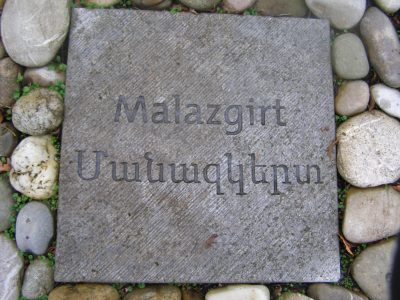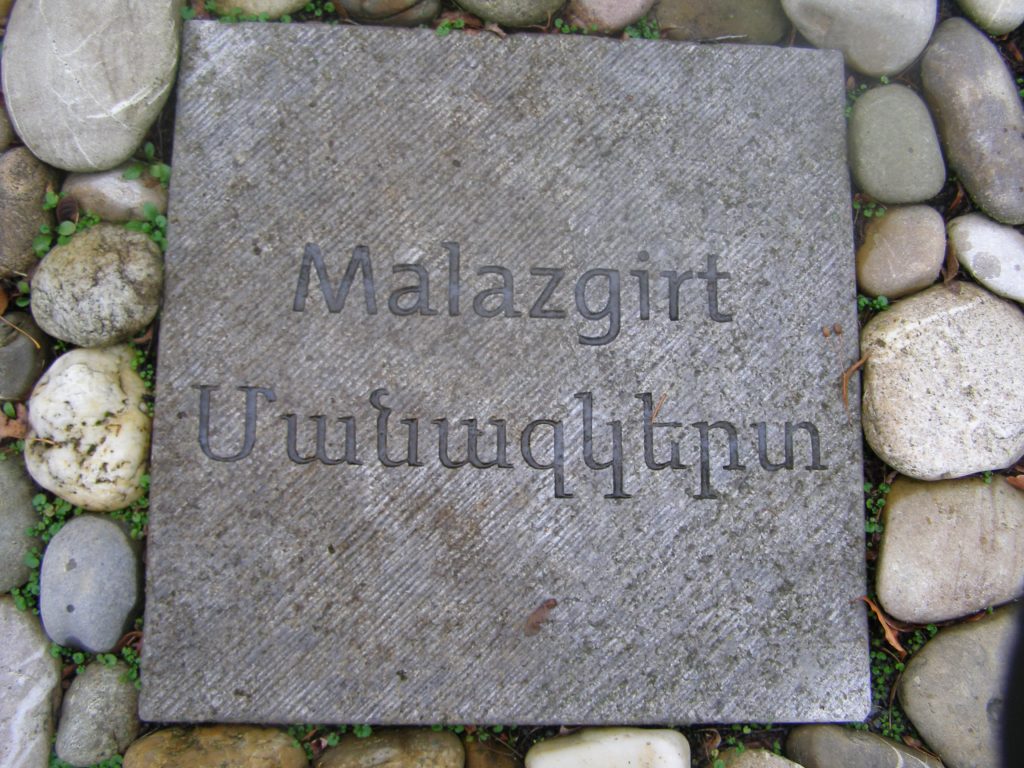
Toponym
The oldest name of the city, Manavazakert (Western Armenian pronunciation: Manavazagerd – ‘Fortress of Manavaz’), according to the Armenian historian Movses Khorenatsi, refers to King Manavaz, the grandson of the mythical founder of the Armenian royal dynasty, Hayk. From the year 390 it became the place name Manzikert or Manazkert (Manazgerd); the name form Malazgird is documented from 952.
Manavaz probably refers to the Urartian ruler Menua (c. 810-778 B.C.), whose inscription was found in Adaköy, close to the town center.[1] Menua developed a canal and irrigation system that stretched across his kingdom.
The Urartian rock inscription of Adaköy, southwest of Malazgirt tells of the construction of irrigation works by King Menua:
“To the god Ḫaldi the Mighty, Menua son of Išpuini dug this canal. Its name is ‘Menua channel’ (Menuai pili). He has dug it from the Menua Valley to the city of Uliš[…]ini, to the city […]”.
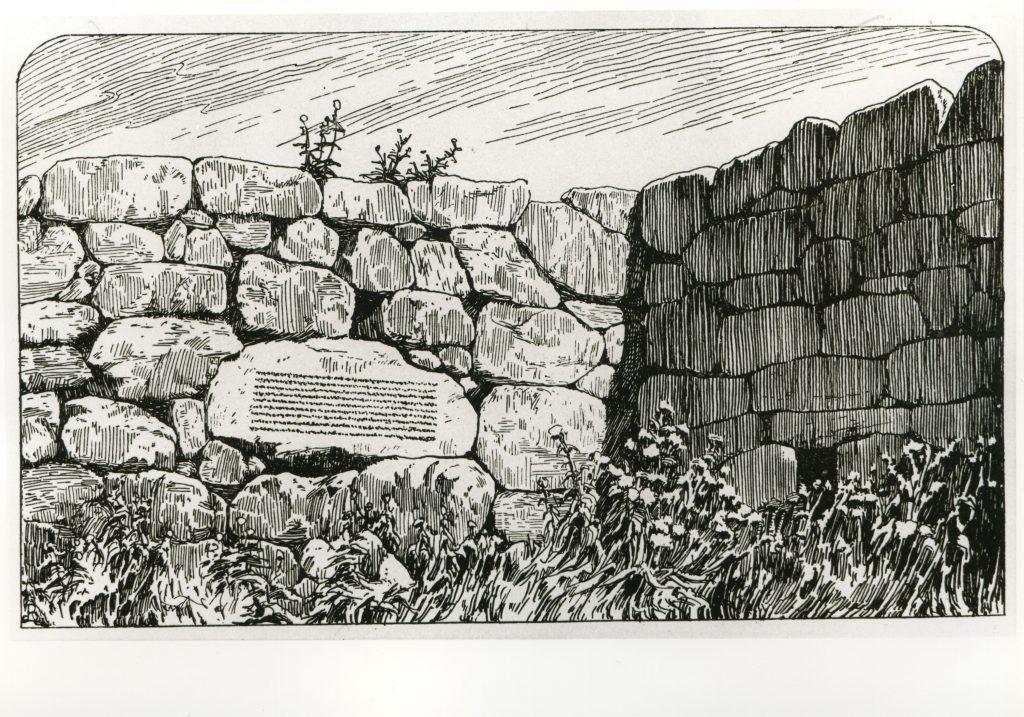
Population
In 1891 the district had 21,000 inhabitants, of which 12,000 were Muslims and 9,000 Armenians, living in 40 of a total of 126 villages. According to the Armenian Patriarchate of Constantinople, in 1914 there lived 11,931 Armenians in 39 localities of the kaza of Manazkert, maintaining 25 churches and 45 monasteries, 15 parish schools with 527 students.[2] In 1915, the administrative seat of the Manazkert kaza had 5,000 inhabitants, mostly Armenians, who were engaged in grain cultivation, partly in trade and handicrafts.
Part of the Armenian population of the kaza converted to Islam during the events of 1895. At the beginning of the 20th century, Christian and Islamized populations lived together in many villages. Until the 1980s, the majority of this population were immigrants from Ahıska, Çıldır, Şavşat, Erzurum and Kars. Today, most of the town of Malazgirt is of Kurdish origin. There are still a few Kurdish-Islamized Armenian families living in Malazgirt.
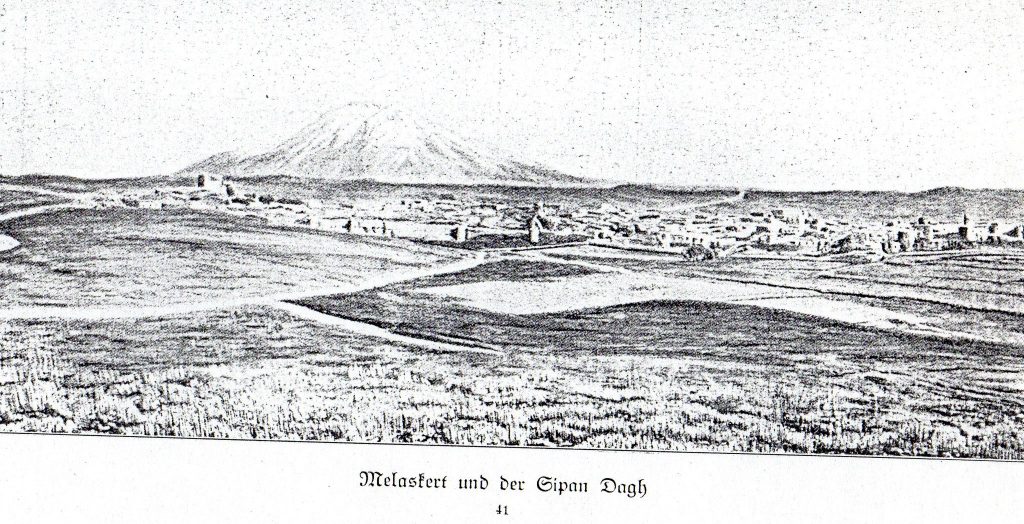
History
Manazkert belonged to the Apahunik’ (Ապահունիք) canton of the Turuberan province of ancient Greater Armenia. The history of this canton was marked by numerous mass exoduses and displacements due to war.
The most fateful battle that took place in this region was the Seljuk-Byzantine Battle of Man(t)zikert on 26 August 1071. The defeat of the Byzantine forces, as well as the capture of Emperor Romanos IV Diogenes, significantly undermined Byzantine rule in Anatolia and Armenia and favored the gradual Turkification of Anatolia.
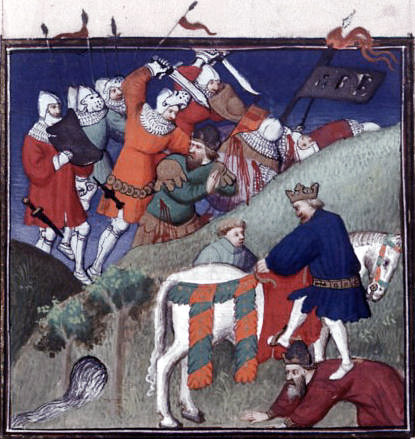
The Kurds who settled in the district in the 13th century expelled the Armenian population from certain regions. During the Ottoman-Persian wars in the 16th and 17th centuries thousands of Armenians were killed or deported. The inter-ethnic clashes of the Kurdish Beys, which took place in the second half of the 18th century, deserted dozens of Armenian villages. Many Armenian families emigrated from Manazkert, settling in Eastern Armenia in 1829-1830, after it had passed to the Russian Empire. Since 1831 the Ottoman state began to populate the emptied villages with Kurds. In the 1870s, refugees (Circassians) from the North Caucasus settled in several villages. After the massacres of 1895-1896, many Armenian families moved to Manazkert from Khiza, Mamrtank, Sparkert and other mountainous districts of Bitlis province.
Among the famous villages were Rustamgyaduk (historical Rostomashen; pop. 1,800, 1914), Noradin (pop. more than 1,700, 1914) with the Hovhan Odznetsi Monastery, Tondrak (Tonrak, Tondras; Trk.: Tendürek) village (the ruins of St. Hovhannes Monastery were preserved in the area). The villages of Hysen (historical Arse), Marmus (historical Marmonts), Avtna (historical Ghurchka), Kazgol (historical Khazghughk) are remembered at different times. Among the prominent settlements were Derik, Dugnuk (Dignuk), Khasmik, Khotanlu (Kotanlu), Karakayan (Kharakhala).
At the beginning of the 20th century, a number of monasteries were known (mainly half-ruined), the most famous of which was the Apahunyats Monastery (St. Nikoghayos (Saint Nicholas) or St. Astvatsatsin, the ruins near the Armenian-populated village of Kuruja (Khrujen).
In May 1915, due to the advance of the Russian army in Western Armenia, the Armenians of Manazkert escaped mass destruction. However, in July they were forced to emigrate. In 1917, about 5,000 Armenians were resettled in three dozen villages of the kaza of Manazkert, but had finally to leave.
Raymond Kévorkian: Massacres and Evacuation in the Kaza of Manazgerd
“In the kazaof Manazgerd (…) conscription spawned acts of extreme violence, as it did in other areas as well. According to an Armenian witness, men between the ages of 18 and 35 were inducted into combat units, while those between the ages of 35 and 50 were assigned to transport units; most of the latter were killed by Kurdish çetes upon their return from the front. Arms were collected in Manazgerd as early as mid-April, which led to only limited violence. It was also in this period that the Turkish army beat a hasty retreat under pressure from the Russian forces, which had advanced as far as Tutak, in the northeastern part of Melazkırt [Manazkert]. The army systematically plundered Armenian villages as it withdrew, while incorporating an average of 30 to 40 men from each village.
Guided by the kaymakam Halet Bey and two Hamidiye officers, Sarti Berg and Süleyman Beg, the army methodically looted the following villages: Noradin (pop. 1,671; 70 people were killed), Kharaba-Khasmig (pop. 234, 20 killed), Erzaghi-Khasmig (pop. 662), Sultanlu (pop. 116), Molla-Mustafa (pop. 217, 20 killed) Kotanli (pop. 400, 20 killed), Terig/Gereg (pop. 922), LKhanoghli (pop. 234), Rsdamgedig (pop. 1,800, 30 killed), Tundras (pop. 171), Agner-Sheytanava (pop. 421), Pert/Manazgerd (pop. 945), Ekmal (pop. 160), Aynakhoja/Eknakhoja (pop. 360), Oghzkhan/Okhkin (pop. 90), Mollahpagh (pop. 110, 10 killed), Karakaya (pop. 725), Marmus (pop. 300, 20 killed), Dolazbash (pop. 300), Pakran (pop. 155) and Panzden (pop. 237, 30 killed). Those killed in the villages were the young men still living in them – as a rule, adolescents. They were ‘recruited’ by the commander of the Hamidiye çetes, Haci Hamdi Beg, officially in order to carry out military transport. Conducted under guard to a place near Kotanli, in the valley of the Murad Su [Euphrates], they were, on the testimony of a few survivors, shot and thrown into the river.
One hundred families from the administrative seat of the kaza, Pert/Melazkırt, together with 250 from the villages mentioned above, were grouped together in Agner by two Kurdish chieftains, Ibrahim Beg’s son Abdüllah and Hüseyin, who protected them from harm. They fled to Alexandropol [today’s Gyumri] in the Caucasus when the Russian forces took control of the region in May; so did the Armenians from the villages of Hasse (pop. 72), Gushdian (pop. 52), Hasan Pasha (pop. 47), Ganigor (pop. 54), Dugnug (pop. 428), Endris (pop. 105, Kharali (pop. 58), Yaramish (pop. 73), Sardavud (pop. 49), Premasian (pop. 27), Hajipor (pop. 79), Khanek (pop. 51), Keranlegh-Kirali (pop. 83), Mkhchin (pop. 145), Khoshajin (pop. 43), Poyi-Chabghun (pop. 57), and Dorokhan (pop. 268).”
Excerpted from: Kévorkian, Raymond: The Armenian Genocide: A Complete History. London, New York: I.B. Tauris, 2011, p. 349f.
Manazkert Town
Situated on the left bank of the middle stream of the Eastern Euphrates (Grk.: Ἀρσανίας – Arsanias, Arm.: Aradzan; Trk.: Murat), the village or town of Manazkert was the center of the Apahunik canton and seat of Mavazyan ministers in the Turuberan Province of Greater Armenia. It is supposed that Manazkert is the same Arzaghku capital of the first king of Urartu (Van), Arame, founded in the first half of the 9th century B.C. It is believed that Manazkert was founded by King Menua (c. 810-778 BC).
Several cuneiform inscriptions of Menua are preserved in the region. Manazkert was ruled by the Manavazyans until the 4th century A.D. After the annihilation of this dynasty, the Armenian king Khosrov II Kotak, together with the district of Manazkert, granted it to the Aghbianos dynasty, which made Manazkert an episcopal city. Byzantine historian Ioannis (John) Skylitses (11th century) reports that Manazkert was the strongest, impregnable city in all of Armenia, with three rows of stone towers with 5 gates.
11-13th centuries Manazkert was the second center of the Shah i-Armen emirate, its significance was inferior only to the throne city of Ahlat (Arm.: Khlat). Crafts, internal and external trade were developed in Manazkert. It was connected with a number of cities of Armenia by the way passing through the Euphrates valley and the Manazkert plain.

In 968 the Byzantine army captured Manazkert. In 1000, Emperor Basileios presented it to the Armenian princes of Artsruni. In 1054, Manazkert was attacked by the Seljuks led by Sultan Tughril. The garrison and inhabitants of Manazkert, under the leadership of Prince Vasak, forced the Seljuk army to retreat. Completely occupying Northern Armenia, the Seljuk troops on 26 August 1071 near Manazkert clashed with Byzantine, Armenian and other troops, plundered Manazkert, slaughtered the population, after which the city continued to decline, gradually turning into an ordinary village.
During the Genocide of 1915, the Armenian population of Manazkert was subjected to massacres and deportations, and Armenian life there ceased.
